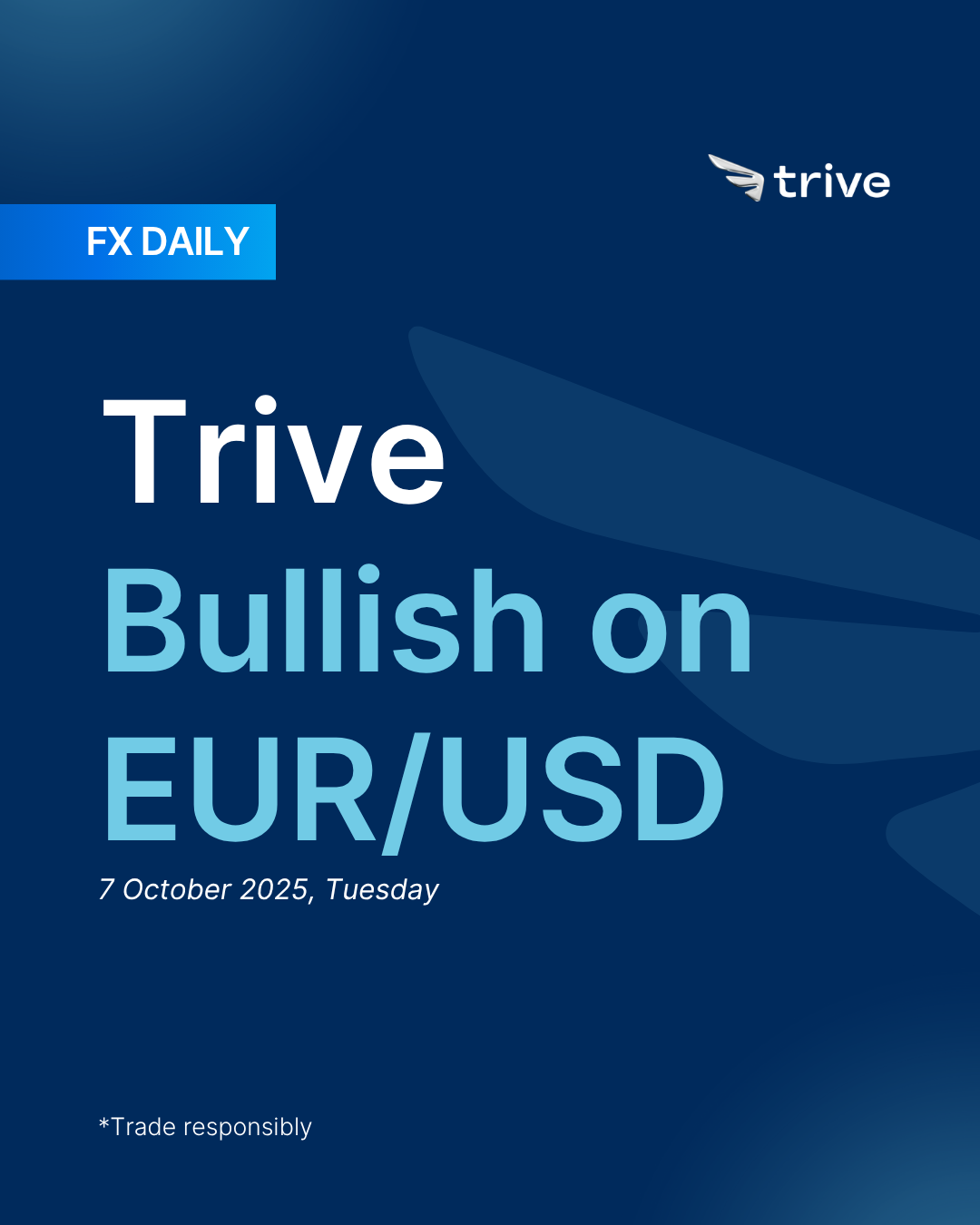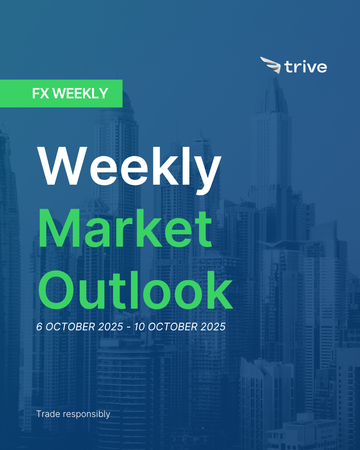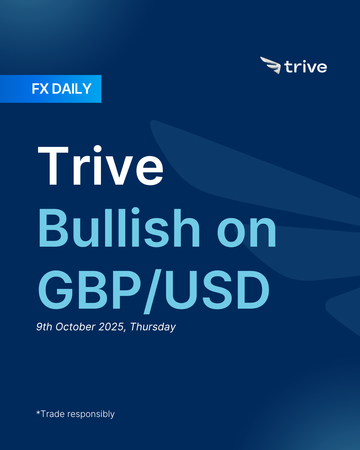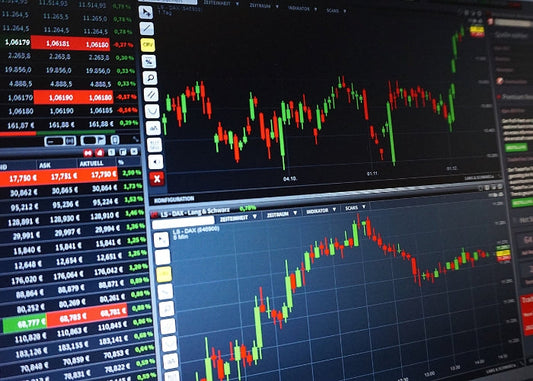FX Daily: Trive Bullish on EUR/USD

The euro climbed to multi-week highs as dollar weakness dominated, with the US government shutdown and dismal private data triggering aggressive Fed cut repricing. Eurozone data stayed mixed, but sticky services inflation, contained spreads, and steady ECB guidance support the currency. Near term, the euro benefits from a dovish Fed tilt and stable risk tone; longer term, gradual differential compression as the Fed cuts faster than the ECB and a solid external balance favor further euro upside.
EUR: Short term strength
The Euro benefited strongly from the sharp US Dollar sell-off, with EUR/USD climbing to a multi-week high near 1.1780. However, the rally was driven almost entirely by the worsening US economic outlook and the government shutdown, rather than any meaningful strength within the Eurozone itself. Although the region’s September inflation data ticked slightly higher, it was not enough to alter the European Central Bank’s firm stance of keeping rates on hold. The Eurozone’s own growth signals remained modest, leaving the single currency as more of a passive beneficiary of dollar weakness than a true driver of its own gains.
The key data point for the week was the flash Eurozone HICP report for September, which rose to 2.2 percent year-on-year, matching expectations and pushing headline inflation slightly above the ECB’s 2 percent target. Still, the increase was widely viewed as temporary and had little effect on markets. The Supercore HICP stayed unchanged at 2.3 percent, while services inflation edged up slightly to 3.2 percent, showing that underlying price pressures remain sticky. National CPI data earlier in the week painted a mixed picture, with France coming in softer than expected and German states reporting higher price growth that was later confirmed at the national level. Growth indicators were similarly uninspiring, with the final September Manufacturing PMI revised slightly higher to 49.8, while the final Services PMI slipped to 51.3. The Composite PMI of 51.2 signaled continued but lackluster expansion. Meanwhile, the Eurozone unemployment rate rose marginally to 6.3 percent, up from 6.2 percent, but still near historical lows.
On the policy front, the European Central Bank maintained its steady, wait-and-see approach. President Lagarde said that inflation risks appear contained, while Vice President de Guindos described current interest rates as adequate. Governing Council member Wunsch echoed this sentiment, noting that policy is in a good place. Early in the week, Makhlouf suggested that the ECB’s easing cycle is “near the bottom,” reinforcing the view that the threshold for further rate cuts is high. Market pricing remained unchanged, with investors continuing to expect no additional policy moves through 2025, keeping attention primarily on the Federal Reserve’s next steps.
Market sentiment clearly favored the Euro as traders exited US Dollar positions. The “sell America” narrative that took hold mid-week, following the weak ADP report and the US government shutdown, led to a broad shift into the Euro as the most liquid alternative currency. Still, the Euro’s rally lacked independent momentum, with a sudden reversal from the weekly highs on Wednesday underscoring how fragile the move was. The currency’s gains were largely dependent on continued dollar weakness rather than any renewed confidence in the Eurozone’s own fundamentals.
The euro advanced alongside the broad dollar sell off, climbing to multi week highs before fading as momentum cooled. The move was driven more by the US narrative than by a renewed Eurozone impulse, though steady ECB guidance and contained spreads helped underpin the currency.
Near term weak bullish. The ECB’s higher for longer stance, sticky services inflation, and stable sovereign spreads keep a modest tailwind in place, while last week’s rise in the euro was largely a function of external dollar weakness. Domestically, the front end pricing has nudged up and officials continue to describe policy as adequate rather than easing biased. Externally, the balance of rate differentials could still drift the euro’s way if the Fed leans more dovish in the Minutes or Chair Powell sounds cautious, while risk appetite remains constructive. Watch Lagarde’s remarks and the ECB Minutes for any shift in guidance, along with Eurozone retail sales and sentiment to gauge growth tone. A clear downside surprise in US labor data or softer Fed rhetoric would extend the euro’s support, while a hawkish Fed pushback or a jump in BTP Bund spreads would cap it.
Longer term weak bullish. The medium horizon remains anchored by gradual differential compression as the Fed ultimately cuts sooner and faster than the ECB, with the euro’s external balance and a calmer energy backdrop providing ballast. Domestic drivers are mixed but not rolling over, and fragmentation risks are contained, which keeps the ECB comfortable with restrictive settings for now. Externally, a softer US growth path and stable global risk tone favor a slow grind higher in the euro basket, even if occasional risk off waves produce setbacks. We would dial this stance up on a run of firmer wages and core services inflation paired with resilient PMIs and tight spreads, or if front end yields in the euro area reprice higher again. We would dial it down if a sequence of soft inflation and wage prints pushes the ECB toward an earlier easing signal or if spreads widen persistently on fiscal or political stress. If the narrative flips meaningfully or if policy guidance shifts more dovishly than expected, we will reconsider and lean toward a weaker currency until the data and pricing improve.
USD: Short at rally
The US Dollar sold off sharply this week, driven by a dramatic turn in the economic narrative that was amplified by the US government shutdown. The DXY started the week on a soft note, but selling intensified mid-week after Congress failed to pass a funding bill, triggering a shutdown and a data blackout for key reports like Non-Farm Payrolls. This situation placed significant focus on private-sector data, which delivered a major blow to sentiment. Wednesday’s ADP employment report showed an unexpected contraction of 32,000 jobs, sending the dollar into a steep decline and cementing expectations for a Fed rate cut in October. The bearish tone was reinforced on Friday when the ISM Services PMI fell to the breakeven level of 50.0, with new orders contracting. With official labor market data on hold, the private surveys painted a picture of a rapidly cooling economy, forcing markets to reprice the Fed’s path in a more dovish direction and leaving the dollar near its weekly lows.
The ADP report was the main catalyst, showing a loss of 32,000 private-sector jobs instead of the expected gain of 50,000, while the previous month was revised lower into negative territory. The ISM Services PMI confirmed the slowdown, falling to 50.0, its weakest reading since May 2020, driven by declines in business activity, new orders, and employment. The government shutdown, effective from Tuesday midnight, led to a suspension of data releases from key agencies such as the Bureau of Labor Statistics and the Department of Labor, meaning both weekly jobless claims and the crucial September Non-Farm Payrolls were not published. Other data early in the week offered little relief. Pending Home Sales for August came in strong at plus four percent, but the JOLTS Job Openings report and Consumer Confidence showed mixed signals. The ISM Manufacturing PMI remained in contraction at 49.1, slightly above expectations but still signaling weakness.
At the start of the week, several Fed officials, including Hammack and Logan, maintained a hawkish tone, stressing the need for restrictive policy to contain inflation. However, after the weak ADP report, markets swiftly shifted toward expecting rate cuts. By Wednesday, a 25-basis-point cut for October was fully priced in, with almost half a percentage point of total easing expected by year-end. Later in the week, some officials acknowledged the uncertainty caused by the shutdown. Goolsbee pointed out that while private labor data exists, there is less for inflation, which complicates the Fed’s job. Governor Miran added that he expects strong disinflation in services and sees the neutral rate at around 0.5 percent. Despite this dovish repricing, several officials continued to highlight tariffs as an upside risk to inflation.
The government shutdown dominated political headlines. The failure to pass a funding bill not only created a data blackout but also raised worries about political dysfunction and its potential economic consequences. S&P warned that the shutdown could reduce GDP growth by 0.1 to 0.2 percentage points per week. Early in the week, President Trump’s comments about new 100 percent tariffs on certain imports dampened risk sentiment. Meanwhile, US-China tensions persisted as officials exchanged sharp remarks, though both sides expressed hope for progress in upcoming talks.
Market sentiment shifted dramatically from cautious to outright negative toward the US. The combination of the shutdown, weak data, and uncertainty surrounding official releases fueled a “sell America” narrative. The data blackout forced investors to rely on private reports, which magnified their influence and heightened overall uncertainty. Traditional safe havens benefited from this environment, with the yen and gold both strengthening, and gold reaching a new all-time high during the week as investors sought protection from the rising instability.
The US Dollar suffered one of its sharpest weekly sell-offs of the year, sliding lower as the combination of a government shutdown and dismal private data shifted sentiment decisively against the currency. The ADP employment report’s unexpected contraction and the ISM Services PMI’s collapse to 50.0 triggered a wave of dovish repricing, with markets now fully expecting an October rate cut. The absence of official data due to the shutdown only amplified the effect of these private surveys, deepening uncertainty and reinforcing the perception that the US economy is losing momentum faster than previously thought.
Near term weak bearish. The dollar’s tone remains fragile after the shutdown-driven data blackout and the soft private indicators, which have led markets to front-load easing expectations. Even if sentiment stabilizes somewhat, the lack of official confirmation from the labor market leaves the bearish bias intact for now. The focus will turn to the FOMC Minutes on Wednesday and Chair Powell’s speech on Thursday for clues on how the Fed is reading the data gap, while Friday’s tentative job report could decide whether the recent sell-off extends. If these events reveal any hint of tolerance for weaker growth, the dollar may stay under pressure near term.
Longer term weak bearish. The broader setup continues to favor gradual USD underperformance as growth slows and the Fed eventually resumes cutting. The political backdrop and rising fiscal uncertainty only reinforce that trajectory, even if occasional safe-haven demand cushions the downside. Dollar strength could return temporarily if the FOMC pushes back against aggressive easing bets or if official data, once resumed, show a stronger labor rebound. Otherwise, fading activity and softer inflation trends should maintain a mild bearish bias through year-end. If the driver mix flips meaningfully or if policy guidance shifts more dovishly than expected, we will reconsider and lean toward a weaker currency until the data and pricing improve.

EUR/USD 4H
Disclaimer
This material is provided for informational purposes only and does not constitute financial, investment, or other advice. The opinions expressed in this material are those of the author and do not necessarily reflect the views of Trive International. No opinion contained in this material constitutes a recommendation by Trive International or its author regarding any particular investment, transaction, or investment strategy. This material should not be relied upon in making any investment decision.
The information provided does not consider the individual investment objectives, financial situation, or needs of any specific investor. Investors should seek independent financial advice tailored to their individual circumstances before making any investment decisions. Trive International shall not be liable for any loss, damage, or injury arising directly or indirectly from the use of this information or from any action or decision taken as a result of using this material.
Trive International may or may not have a financial interest in the companies or securities mentioned. The value of investments may fluctuate, and investors may not get back the amount they originally invested. Past performance is not indicative of future results.
For more information about Trive International, please visit http://trive.com/int
Additional Information
Investing involves risk, including the potential loss of principal. Diversification and asset allocation strategies do not ensure a profit or guarantee against loss. The content in this material is subject to change without notice and may become outdated or inaccurate over time. Trive International does not undertake any obligation to update the information in this material.
By accessing this material, you acknowledge and agree to the terms of this disclaimer. If you do not agree with these terms, please refrain from using this information.
No comments
Home
Trive
TriveHub





0 comments